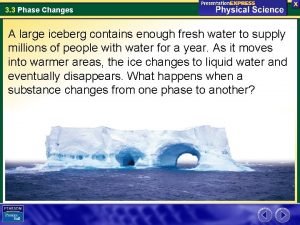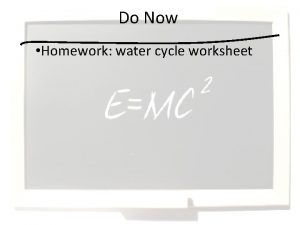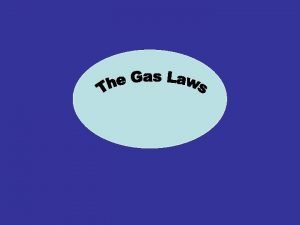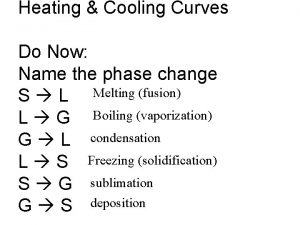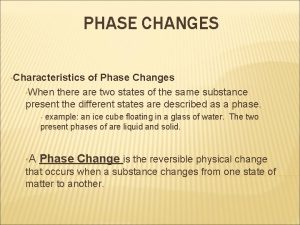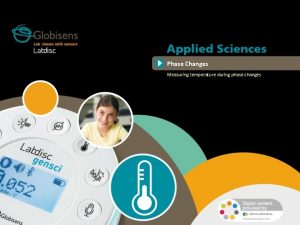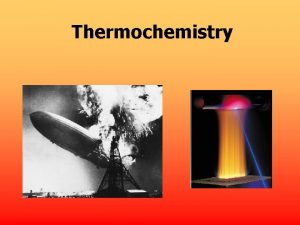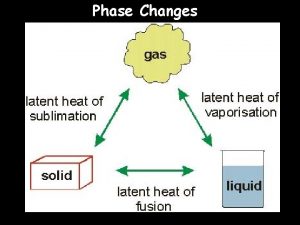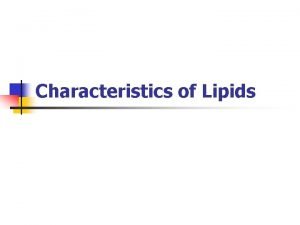Phase Changes Characteristics of Phase Changes l A

















- Slides: 17

Phase Changes

Characteristics of Phase Changes l A phase change is the reversible physical change that occurs when a substance changes from one state of matter to another. l Melting, freezing, vaporization, condensation, sublimation and deposition are six common phase changes.

Temperature and Phase Changes l The temperature of a substance does not change during a phase change.


Energy and Phase Changes l During a phase change, energy is transferred between a substance and its surroundings. l Energy is either absorbed or released during a phase change.

Endothermic l During an endothermic change, the system absorbs energy from its surroundings. ¡EX: Melting, Vaporization, Sublimation

Heat of Fusion l The energy a substance must absorb in order to change from a solid to a liquid. l Fusion is another term for melting.

Exothermic l During an exothermic change, the system releases energy to its surroundings. ¡EX: Deposition, Condensation, Freezing

Melting and Freezing l The arrangement of molecules in water becomes less orderly as water melts and more orderly as water freezes.

Vaporization l The phase change in which a substance changes from a liquid into a gas is vaporization. l Vaporization is an endothermic process. l Heat of vaporization is the energy a substance must absorb in order to change from a liquid to a gas.

Two Vaporization Processes l Evaporation takes place at the surface of a liquid and occurs at temperatures below the boiling point.

Evaporation l Evaporation is the process that changes a substance from a liquid to a gas. l The greater the surface area of the container, the faster the water evaporates.

Vapor Pressure l Vapor pressure is the pressure caused by the collisions of particles in a vapor with the walls of a container.

Condensation l Condensation is the phase change in which a substance changes from a gas or vapor to a liquid.

Sublimation l Sublimation is the phase change in which a substance changes from a solid to a gas or vapor without changing to a liquid first. l Sublimation is an endothermic change.

Deposition l Deposition is when a gas or vapor changes directly into a solid without first changing to a liquid. l This exothermic phase change is the reverse of sublimation.

 Changes in latitudes, changes in attitudes meaning
Changes in latitudes, changes in attitudes meaning What's a physical change
What's a physical change Four phase changes
Four phase changes Heating cooling curve
Heating cooling curve 6 phase changes
6 phase changes Phase change worksheet doc
Phase change worksheet doc Phase change descriptions
Phase change descriptions R constant
R constant Are phase changes reversible
Are phase changes reversible Vaporization endothermic or exothermic
Vaporization endothermic or exothermic Phase changes
Phase changes Normal phase vs reverse phase chromatography
Normal phase vs reverse phase chromatography M tswett pronunciation
M tswett pronunciation Mobile phase and stationary phase
Mobile phase and stationary phase Stationary phase and mobile phase in hplc
Stationary phase and mobile phase in hplc Normal phase vs reverse phase chromatography
Normal phase vs reverse phase chromatography Line current and phase current
Line current and phase current Detectors used in hplc
Detectors used in hplc




